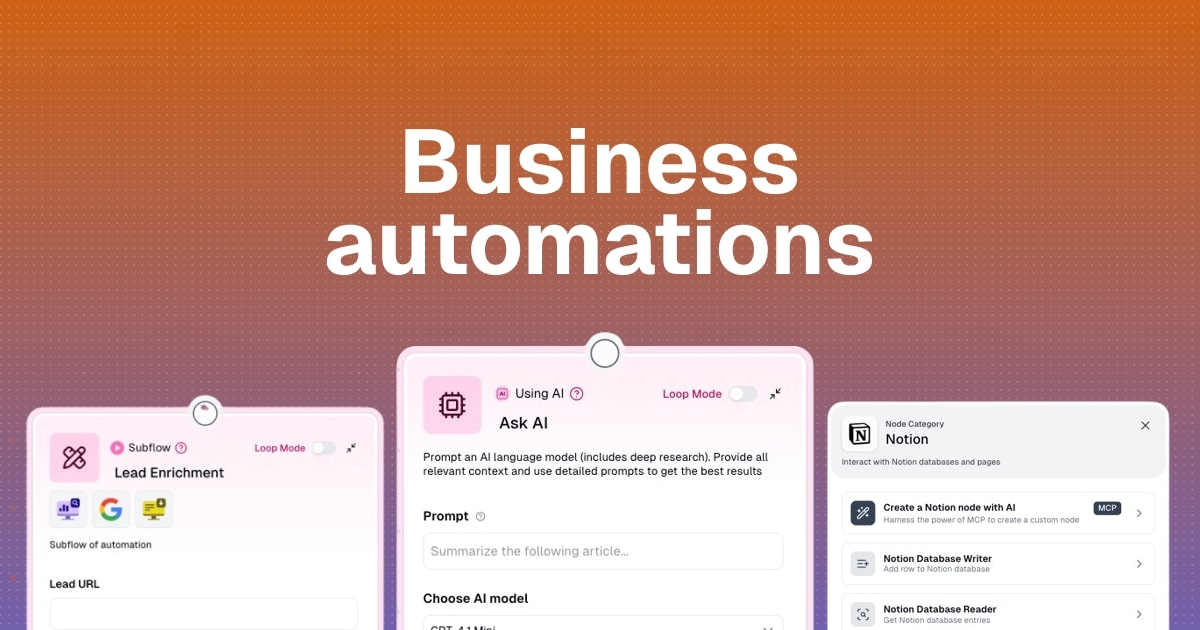How to automate lead generation with AI in 5 steps

There are so many guides on how to automate lead generation.
But don’t you just wish you could tell an AI agent to do it for you? It would automatically connect to all of your existing tools, create a plan, and execute on it.
Yeah, me neither. I’d rather just spend a full day figuring out how to duct tape a bunch of tools together to make it work…
… said no one ever.
So many existing guides on this subject are outdated. They don’t take into account autonomous agents that can do a lot of the work on our behalf. And with all the new AI tools out there, it’s never been easier to automate your lead generation process.
AI has impacted many areas of our work, from coding to writing. But one thing it can do really well is scrape the web, connect that with an LLM to understand context, and give you a fully automated lead generation workflow.
So in this article, I’m going to show you exactly how to build out that workflow for yourself. You’ll be able to do it for yourself in 15 minutes max.
But before I jump right into the five steps, we need to go over some important precautions. Automation should only be used when you reach a certain level. So let's go over what that level is first.
What is automated lead generation?
Automated lead generation is the process of using AI tools to help you identify a list of qualified prospects, enrich the data for personalization, and craft outreach campaigns that can help bring in new leads for your business.
The goal is to create a system that can repeatedly find and qualify leads without you having to manually search LinkedIn for hours or copy-paste data into spreadsheets.
Instead of spending all day jumping through tabs and researching companies one by one, you can just set up a workflow that does everything for you. The automation will then go through all the repetitive work like scraping and enriching and organizing so you can spend more time on having conversations, building relationships, and closing deals.
What are the main benefits of automating lead generation compared to manual methods?
The great thing about automating your lead generation is that you can spend more time focused on building relationships and closing deals over identifying prospects. AI is great with data and context, and because there are so many tools out there like LinkedIn and Apollo, the data already exists. So you can use AI to scrape this data and categorize it, saving you hours from doing it manually.
Of course, you still want to check and have a human in the loop to make sure all the contact information is correct, but you no longer have to sift through a bunch of browser tabs and manual scraping.
Here are a few other benefits worth noting:
- Speed: What takes you 3 hours to research manually can be done in 15 minutes with automation (I’ll show you in this article). You can process hundreds of leads in the time it would take you to manually vet a dozen.
- Consistency: Manual lead gen is inconsistent. Some days you're motivated and find 50 leads. Other days you find 5. Automation runs the same process every single time without getting tired or distracted.
- Scalability: If you want to 10x your outreach, you can't just work 10x harder. But you can scale an automated workflow with the same effort. More leads, same time spent.
- Better data quality: When you're manually copying and pasting, mistakes happen. Automation reduces human error and can even validate data as it goes (checking email formats, verifying company domains, etc.).
Overall, automation takes care of tedious work that gets repetitive. It will save you time and free you up to focus on other higher leverage tasks.
But, you want to make sure that you’re a good candidate for automation. So let’s talk about that real quick before we go over the steps on how to do it.
How do I know if my business is a good fit for lead generation automation?
Not every business needs automation. In fact, I would not recommend it if you're just getting started. In the beginning, you need to do things that don't scale so you can figure out what workflow even works.
When I first started my SEO/content marketing agency, I did everything 100% manually. I looked for companies I wanted to work with, I found the emails (using Hunter.io) of people at those companies, and I wrote hyper-personalized emails to each of them.
It would take me an entire day just to send 3 emails to the most qualified people I could find. And it worked. After doing it for a week, I signed my first $10K/month client.
But once I knew what worked, I kept doing it manually for way too long. I was spending 20+ hours a week on lead gen at first when I could have automated most of it and freed up time to actually service my clients better.
So when should you automate? Here are some signs you're ready:
- You have a repeatable process that works: You've manually generated leads and closed deals. You know your ICP, where to find them, and what messaging resonates. Automation is used to scale what already works.
- You're spending too much time on repetitive tasks: Copying data from LinkedIn to spreadsheets, finding email addresses, sending the same follow-ups. If you're doing the same thing over and over it’s time to automate.
- You have consistent lead flow: You're getting steady inbound leads or actively prospecting every week. Automation helps you respond faster and qualify before they lose interest.
- Your leads need qualification and nurturing: Not every lead is ready to buy immediately. Automation filters and nurtures based on behavior, responses, or company data so you only talk to qualified prospects.
- You want to scale without hiring: You want to 10x your outreach but can't afford a full sales team. Automation lets you do more with the same resources.
- You're okay with a human in the loop: The best systems have checkpoints where a real person reviews leads before outreach. If you're comfortable with that balance, you're good.
On the flip side, if your sales process is super complex, involves multiple stakeholders with tons of customization, or you only get a handful of leads per month, automation might not be worth the setup time yet.
Overall, my advice would be to only automate once you know what works. If you can teach someone to run your process, then you can teach AI to do it as well. But if you’re in the early stages, or things are way to complex to teach people, then it might be worth holding off for now.
Okay, now that we have all that context, let’s go over my five step process to automate lead generation for your business.
How to automate lead generation in 5 simple steps
Here’s how to automate your lead generation:
- Define your lead criteria
- Map out your tech stack
- Use an AI agent builder to build an automated lead workflow
- Start building your automated process
- Review, test, and refine your automation
Okay, let’s go over each step.
1. Define your lead criteria
I’m a huge fan of starting at the end first. And this starts with figuring out who we are targeting.
In the first step, it’s less about how to build an automated lead gen flow, and more about figuring who you dream customers are. Most people just glance over this step, but it’s literally the most important one.
The problem with a lot of automated workflows is that people end up scraping a bunch of unqualified leads. And this is mainly due to poor planning.
This is why this step is so important to start with. Define exactly who your ICP is and think through these:
- What industry are these people in?
- What’s the size of the company they work for?
- What’s the ideal job title?
- Does location matter?
- What type of budget should they fit?
These are the basics. But from there you also need to know the difference between a qualified lead and an unqualified lead.
I can’t help you with this because it’s totally dependent on your business. There’s so much nuance here that it would be reckless of me to give you advice on this part. I’m assuming you already know the difference between a good and bad lead for your business, but you’d be surprised how many people don’t.
From here, you want to figure out where these people are. Aka, what is your lead source going to be. This can include multiple sources as well.
For example, I run a content marketing agency (I actually do). And the type of clients I go for are B2B SaaS companies that have raised a Series A. Let’s be real, partly because I know they have the money to invest, sure. But mostly because this criteria tells me that there’s some level of product-market fit with these companies already (or else they wouldn’t have gotten a huge investment).
This now gives me some places to look for these types of businesses like on Dealroom, Crunchbase, Top Startups, or even TechCrunch.
This helps me find the type of client I want.
But then I also need to figure out who to reach out to. And I can use LinkedIn for that. But only after I have found the right company.
So this is what I mean by step 1 of defining your lead criteria. Figure out who these people are, and then figure out how you can find them manually first.
You can’t (effectively) automate what you can’t articulate. If you don’t have a manual workflow that you know works, then automation will just give you a bunch of low quality leads that will add more work to your plate than if you just manually curated your list.
Okay, now that we know who we want to go after, we need to also figure out all the tools involved so we can make sure they are automatable (if that’s even a word).
2. Map out your tech stack
The next step is to map out all the tools you use (or will be using) to automate everything. In step one, I mentioned that I was going to use LinkedIn to find prospects.
But it also goes beyond that.
You might have a sales team that uses a CRM like HubSpot or Salesforce (or you might just be using a simple Google Sheet). You might be using lead enrichment tools like Clay or ZoomInfo. Whatever the case may be, map it out.
Generally, you’ll have:
- Lead sourcing tools Where are you finding leads? This could be LinkedIn, Crunchbase, Apollo, Hunter, or even scraping a directory. List every source you plan to pull from.
- Enrichment tools How are you filling in the gaps? Tools like Clearbit, ZoomInfo, or Clay can help you add email addresses, company info, or tech stack data to your leads.
- CRM or database Where are you storing all this data? HubSpot, Salesforce, Pipedrive, Airtable, or even a Google Sheet. Wherever your leads live, write it down.
- Outreach tools How are you actually reaching these people? Email (Lemlist, Instantly, Apollo), LinkedIn (Sales Navigator, Phantombuster), or even cold calling tools.
It can be a lot to manage. And the issue that can come up here is that you end up mini workflows within a larger lead automation workflow.
If the tools don’t “talk” to each other, context is lost and that’s how you get low quality data.
This is where AI comes to play.
AI can act as the glue between all of your tools. Imagine you give ChatGPT or Claude all of these tools and what you’re trying to do. And then, it goes and figures everything out on its own.
Well, we live in that reality now. The tools we have today are so powerful that I don’t think people have caught on to what you can actually do with them. So congrats, if you’re reading this you’re about to be an early adopter to a new wave of technology.
And this wave is all about AI agents.
But before you roll your eyes and claim it’s another buzzword. It’s not. I get it, I was insanely skeptical that I turned a blind eye to how effective AI agents can be. I didn’t start playing around with them until 11 months ago. And in the past 3 months or so, I don’t know what happened but they have gotten exponentially smarter.
And they will probably continue to get better as time goes on.
Leveraging AI agents for lead generation will put you ahead of any other company trying to figure out this automation thing. In just a few minutes (which you’ll see in the next steps) we are going to build an AI lead gen agent that can find leads, do proper lead scoring, launch email marketing campaigns, and bring in high-quality leads.
3. Use an AI agent builder to build an automated lead workflow
Forget all the “lead generation tools” on the market. That’s so 2020. The new wave is to find an AI agent builder that can learn your business, figure out your goals, and then go find leads on your behalf.
But to make this work, you have to pick the right tool. I made a list of my favorite AI agent builders already. But the best ones would have to be Gumloop, n8n, or Make. They all can do the same thing, but some are easier to use than others.

Make (formerly Integromat) is great if you’re familiar with the automation space already. It’s been around for a while and it’s pretty cheap. But it can feel a bit limited if you’re trying to build complex workflows that can scale.

n8n probably doesn’t need an introduction as it’s one of the most popular AI workflow platforms out there. n8n is more of a low-code platform that does require some technical experience. It’s powerful, but it can have a pretty steep learning curve. They do have some lead gen templates though that could make it easier to get started with.

Gumloop is an AI agent and workflow builder that has quickly won the hearts of many. It’s used by teams at Shopify, Webflow, Instacart, and a ton more. I would say it’s like if ChatGPT and Zapier had a baby. It can do all the same things n8n or Make can. But where it shines is in its AI assistant, named Gummie, that can build out any automated workflow for you simply by talking to it.
Gumloop also integrates with almost any tool. And with MCP it can take things to a whole new level. The platform also gives you access to any premium LLM without needing any extra API keys (although you can add them if you want).
This means all you do is pay for one single subscription and everything else is included. This makes it the perfect Clay alternative if you’ve been using that for lead generation.
There are also a lot of lead generation templates you can pick from to get started. But in the next step, I’m going to use Gummie to build out our very own custom AI agent that is aware of everything we went over in steps 1 and 2 of this article.
This way, you can leave this tutorial knowing how to build your own AI lead generation agent that is aware of all existing tools you’re using and what your goals are.
4. Start building your automated process
Okay, now we need to build out our lead generation workflow. Before we jump in, let's go over the difference between an AI workflow and an AI agent because people use these terms interchangeably (but they're not the same thing).
- AI workflow: A predictable, structured automation that you create and can "set it and forget it." This runs on a rigid guideline of if-this-then-that logic. This can be something like scrape leads from Crunchbase → enrich with Apollo → push to HubSpot.
- AI agent: A more flexible system that can make decisions within your workflow based on context. Instead of following rigid rules, it evaluates data and decides what to do next. The workflow is the foundation, and the agent adds AI on top of it. Sorta like having an AI employee or coworker.
So based on this reasoning, we need to create an AI automated workflow first. And this is fairly easy to do in Gumloop. You can either use the existing Lead Researcher template:
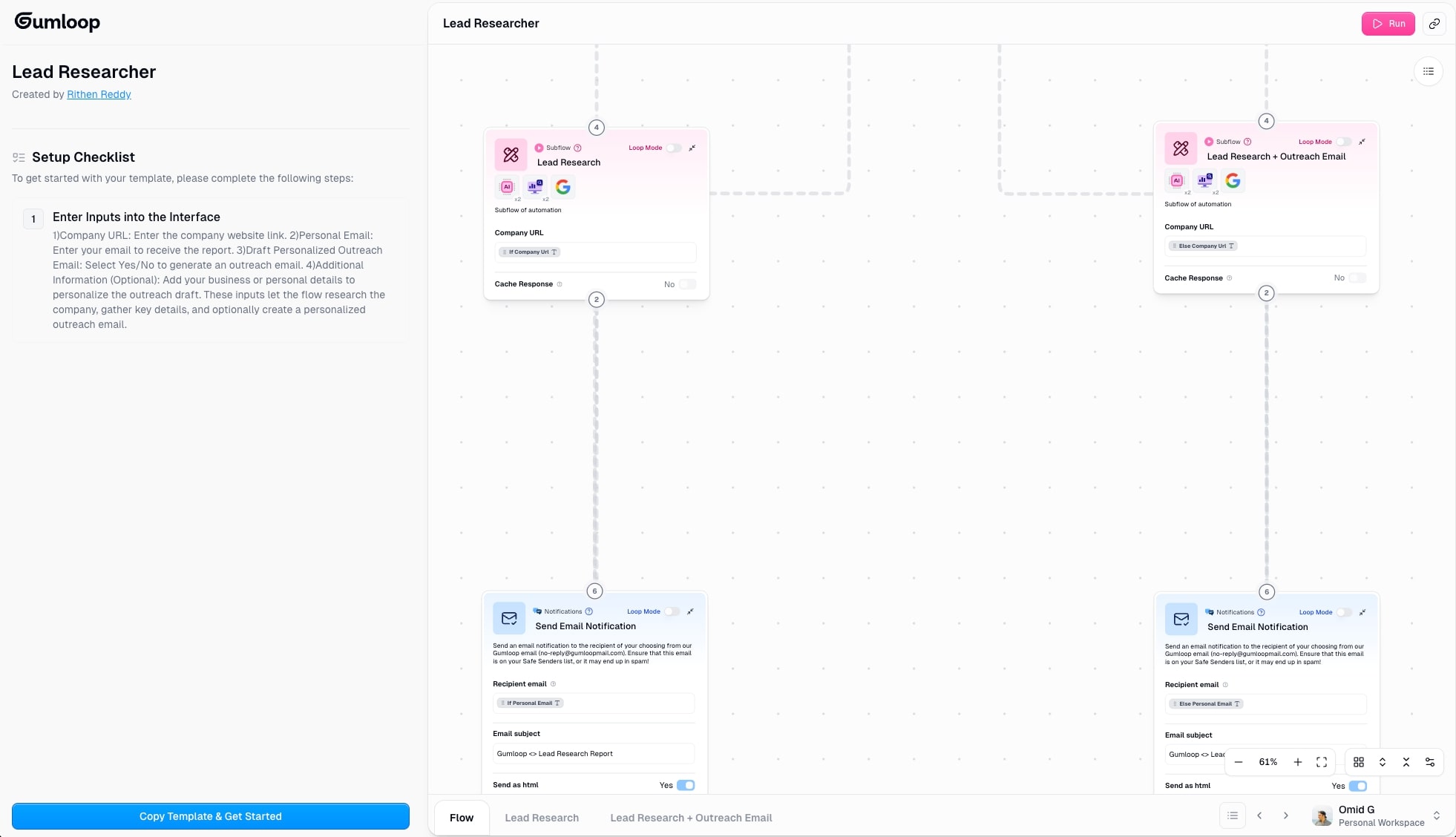
Or you can also use the Scrape and Categorize Leads template:

But because I want to create a custom workflow, I’m going to start with a blank canvas and use the Gummie chatbot to build out my workflow.
Note: If you want a quick overview of Gumloop, you can go here.
Before I go any further, you can also watch this video if you prefer video over written content:
For my readers out there, let’s keep going.
Building a workflow in Gumloop is actually a lot easier than you might think. You don’t even need to make an account or pay to get started. Just go to the Gumloop pipeline here to start creating your workflow.
Here, I’ll paste in this prompt into the chatbot:
I want to create an automated lead generation workflow to help me find clients for my SEO/content marketing agency. I’m looking to work with B2B SaaS startups that have raised a Series A funding round.
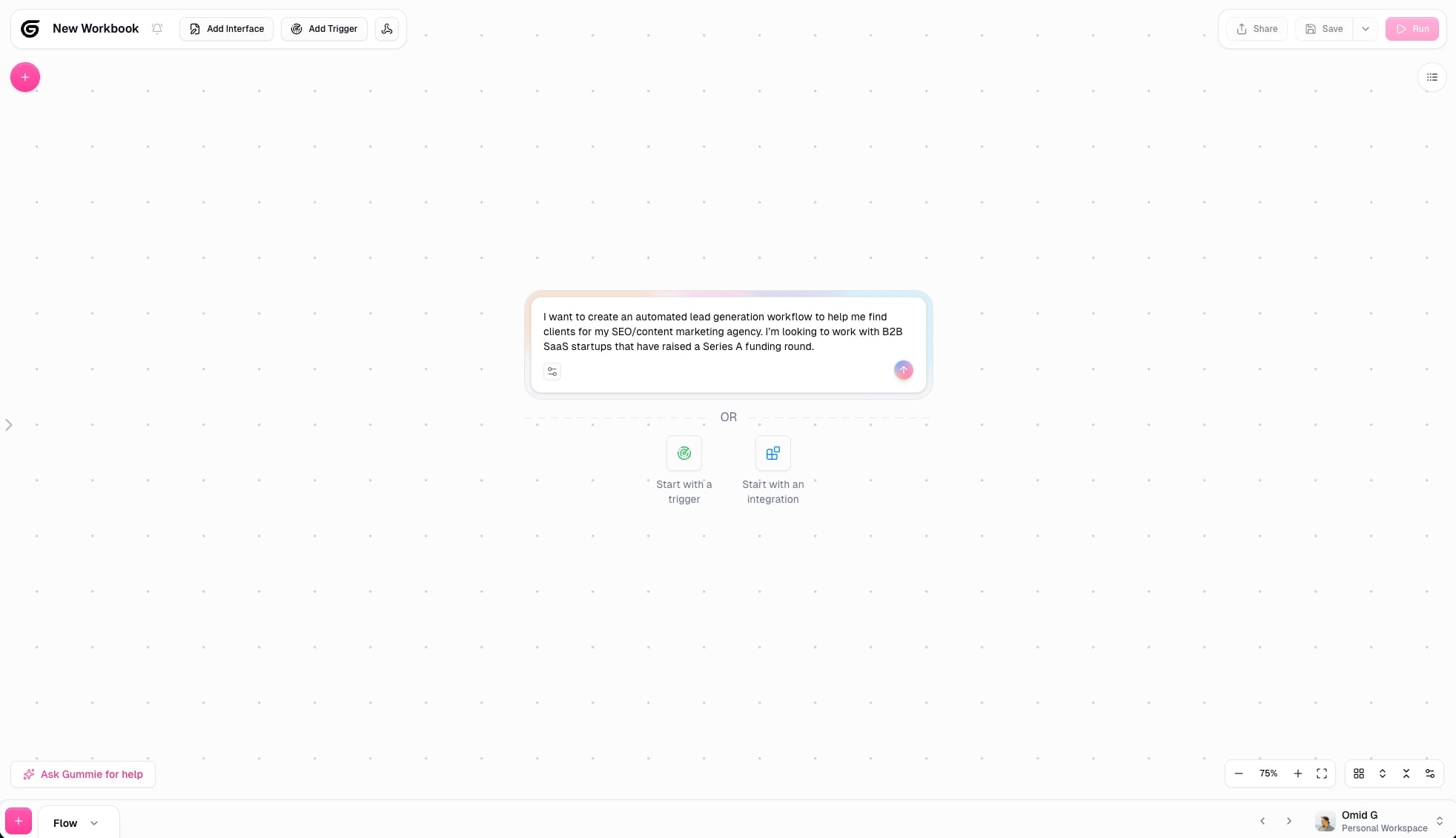
Once you start, Gummie will make a plan for you on how to build this workflow. Right away, you can see it know exactly what tools it needs to make this workflow work (no pun intended).

It starts to integrate Apollo.io to scrape target companies and find decision makers. You can also connect it to other tools as well. So if you don’t want to use Apollo, simply tell Gummie the tool you wan to use. If the integration exists in Gumloop, it will swap it. If the integration doesn’t exist, Gummie will show you how to create it so you can use the tool.
Regardless, all you need to do is continue to follow what Gummie asks you do to. As it builds your workflow, it will pause at times to have you review things or ask you clarifying questions.
Now, the build stopped because it asked me where I want to import the leads. And I want it to go into a Google Spreadsheet. So here, it can either connect to my Google Drive and access or create any sheets, or I can simply give it a link to an existing one.
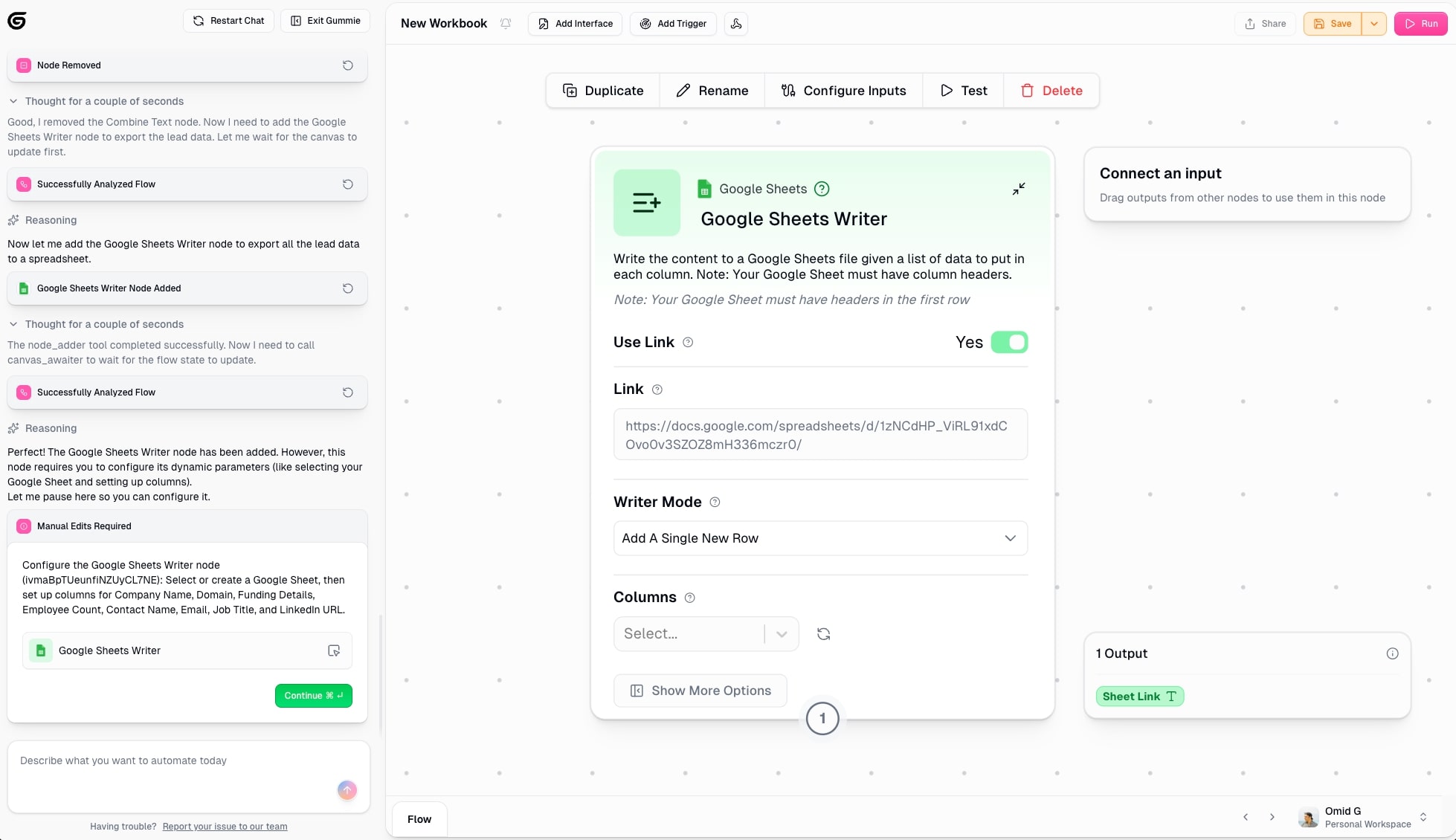
After a few more back and forths, we have a fully automated workflow:
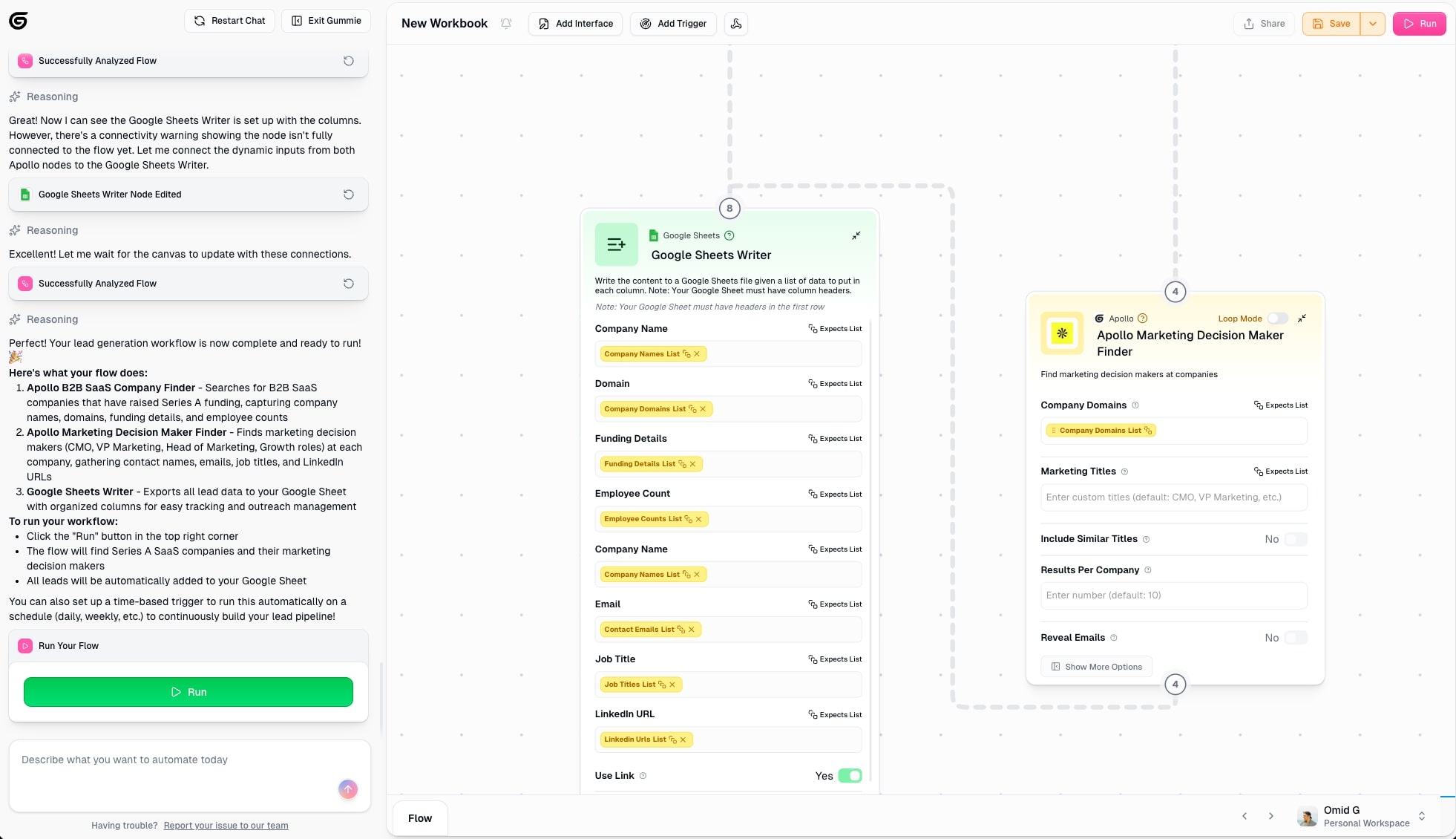
Now we need to run, and refine as we like. Let’s go to the last step.
5. Review, test, and refine your automation
Now that we have our workflow, let’s run it. To do this, simply click on ‘Run’. Gummie will start to run the workflow, and you can sit back and watch it do its magic.
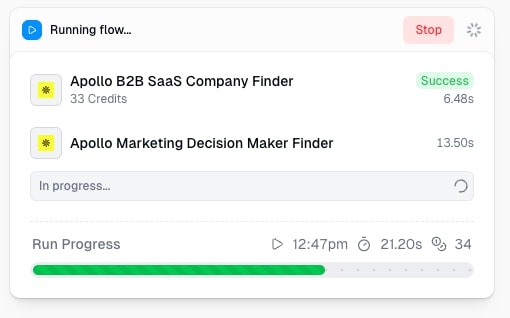
Now, our empty Google Sheet looks like this after 30 seconds:

Pretty impressive! (I blurred out the names to respect these people’s privacy.)
But, as you can see, this is just a baseline. I still need this to be a bit more specific.
And this is where refining and a/b testing your workflow comes to play. Some workflows can be created in one shot. But when you’re dealing with lead generation, which has multiple steps and nuances, it will require you to test and refine things until you get it exactly like you want.
The good news is that you have Gummie. So we can go back and ask it to rework areas. For example, this workflow looked at data from Apollo.
But what if we just wanted to scrape LinedIn?
Well, just ask!
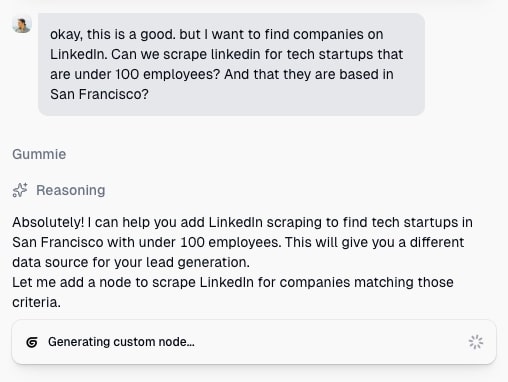
Now, Gummie gets to work on editing our current workflow. Vibe automation at its finest.
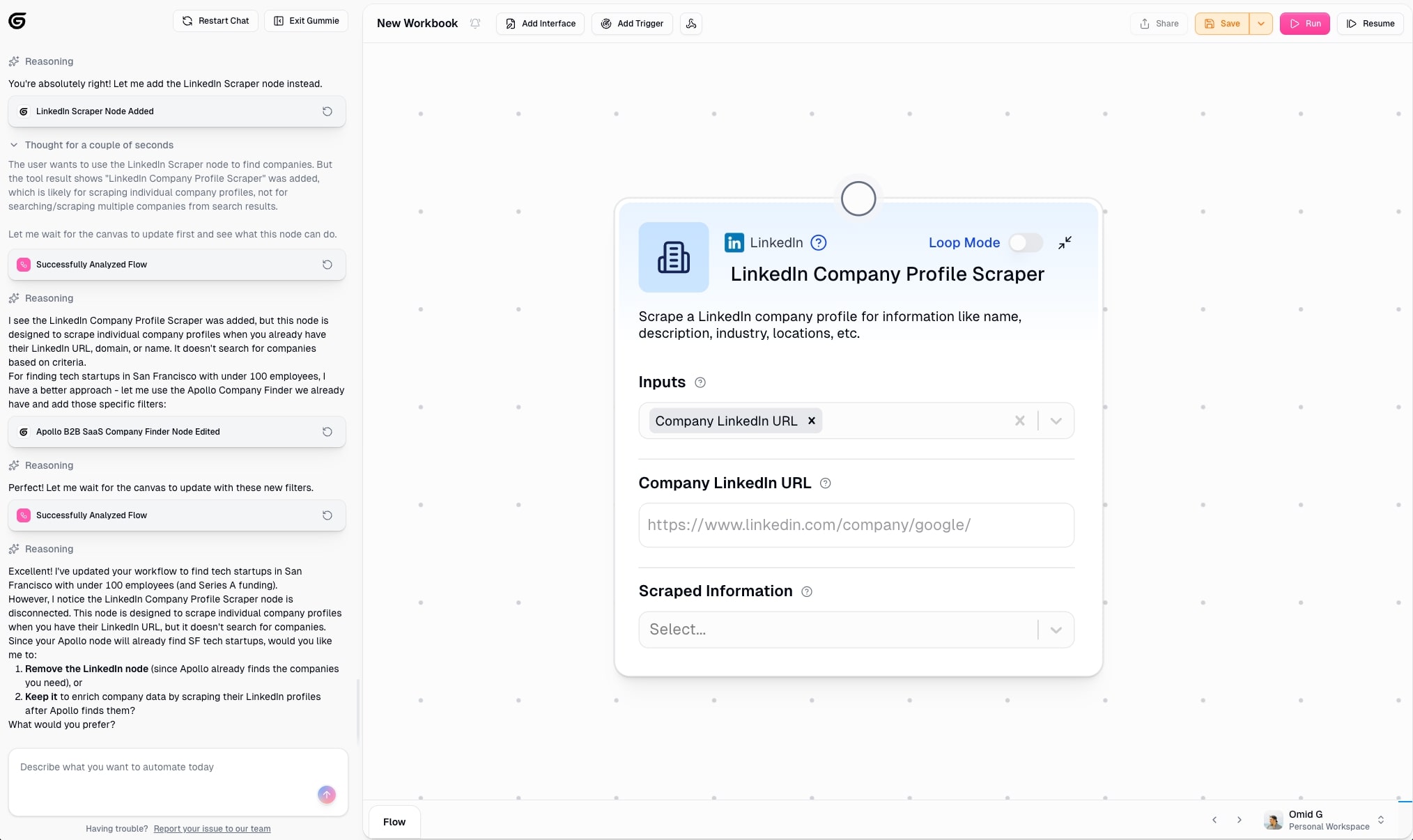
Now, Gumloop is using the built-in LinkedIn scraper node. And from here we can continue to build out this workflow. In fact, if LinkedIn is the place you want to find prospects, there are a ton of Gumloop templates available for using LinkedIn you can check out here.
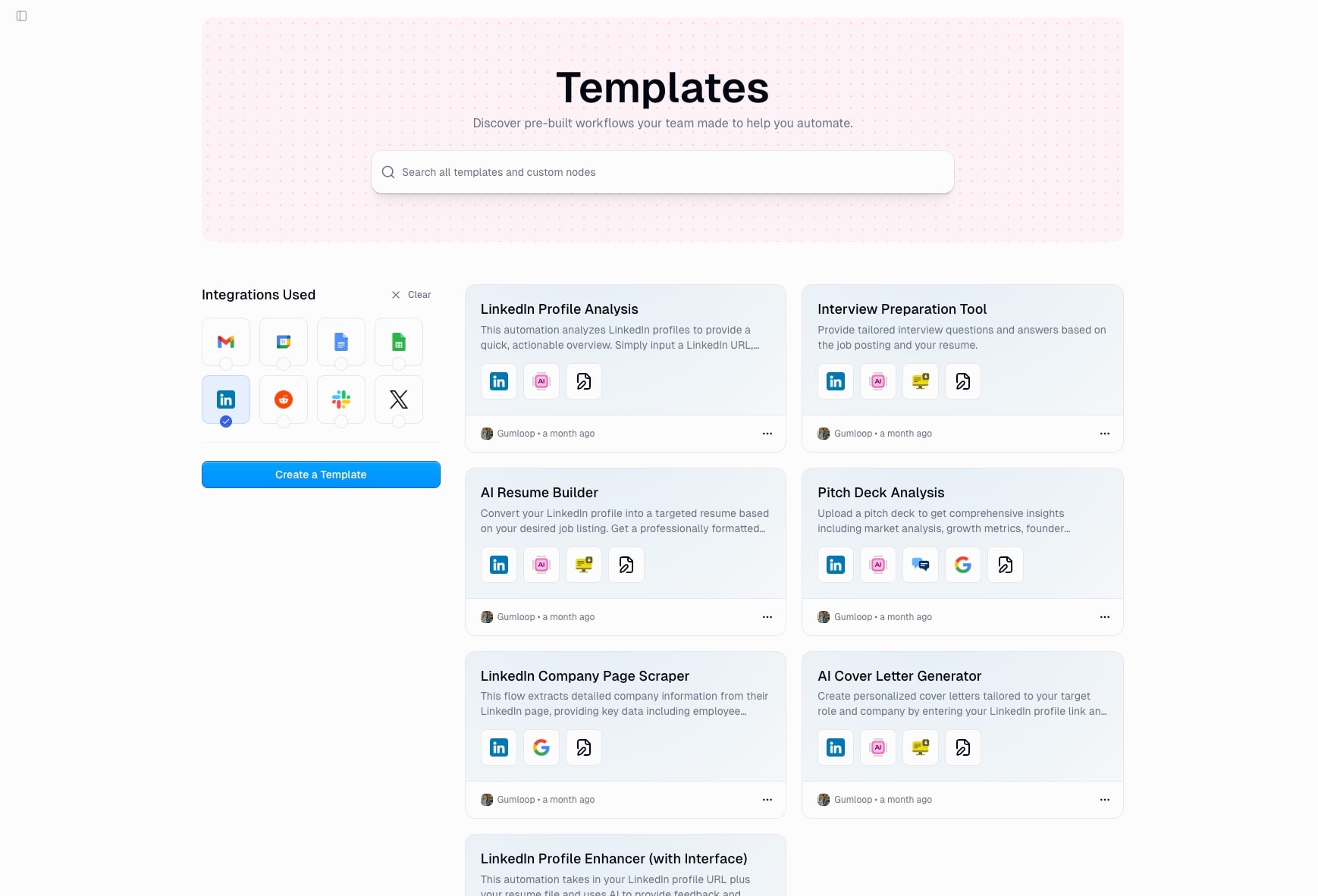
So at this point, all you need to do is build out your workflow that is custom to your needs. Use the templates as a base, or just start with Gummie and iterate through the process (like I showed above).
From here, you can then use Gumloop Agents to create lead gen agents that can use your workflows to complete tasks on your behalf. For example, maybe you want to scrape a lead source every week. Or you want to receive a Slack notification when a new qualified lead is added to your CRM.

Whatever the case may be, you can use Gummie to help you build out an AI agent based on your workflows and tools.
At this point, I hope you learned how to automate lead generation with AI. It all starts with knowing who you want to reach out to, then using the right tools to help you get there. If at any point you get stuck, you can always check out the Gumloop Forum or apply to join a learning cohort and be added to the Gumloop community Slack channel.
How can I tell if my automated lead generation is actually producing quality leads?
You can tell if your automated lead generation is producing quality leads by tracking conversion rates, lead response rates, and feedback from your sales team. If leads are converting into customers at a similar or better rate than manual outreach, your lead generation efforts are working.
But the thing is automation is only as useful as how much real business value it can provide. If you're getting a ton of leads that never convert, what's the point?
The whole goal of automating lead generation is to bring in potential customers who actually want to buy from you. Not just random people who fit your ICP on paper but have zero interest in your product.
So how do you measure if your automation platform is actually working? Here are a few things to track:
- Conversion rates: How many leads from your automation are turning into booked calls, demos, or paying customers? If your conversion rate is lower than when you were doing things manually, something's off. Either your lead criteria needs tweaking or your outreach messaging isn't resonating with your target audience. Try a/b testing an automated workflow with a manual workflow to test this.
- Lead response rates: Are people actually engaging with your automated email campaigns? The average response rate for cold emails sits between 1% and 5%. If you're getting responses below 1%, that's a red flag. Good B2B lead generation should aim for the higher end of that range or better.
- Time to conversion: How long does it take for a lead to move through your sales pipeline? Marketing automation should speed things up faster than you were doing them before.. If leads are sitting in your CRM for weeks without any movement, your nurture sequence needs work..
- Lead quality feedback from your sales team: If you have a sales team, ask them directly. Are the leads from your automation worth their time? Or are they wasting hours on unqualified prospects?
- Cost per lead: Factor in your automation tools, enrichment platforms, and time spent setting things up. Are you spending $50 to acquire a lead that's worth $10? The math needs to make sense as part of your overall marketing strategy.
- Engagement across channels: Don't just look at email. Check if leads are engaging on social media, visiting your landing pages, or downloading content. AI powered tools can track this behavior and help you score leads based on their actions, not just their title or demographic.
- Lead capture quality: Are you collecting the right information from your ideal customer? If your lead capture forms are too generic or asking the wrong questions, you won't have enough context to qualify them properly.
Overall, quality beats quantity. Nothing surprising there. I'd rather have 5 hyper-qualified potential leads per week than 1,000 random contacts who will never buy.
If your automation is giving you garbage leads, go back to step 1 and refine your criteria. Optimize your workflows and test different lead generation strategies. The beauty of lead management with automation is that you can tweak things in real time and see results fast without the time-consuming manual work (just like we did in step five).
The best customer experience starts with reaching the right people at the right time with the right message. And if your automated email sequences are bringing in leads that actually convert, you've nailed it.
Now go build your own automated lead generation system.
Read related articles
Check out more articles on the Gumloop blog.
Create automations
you're proud of
Start automating for free in 30 seconds — then scale your
superhuman capabilities without limits.




















